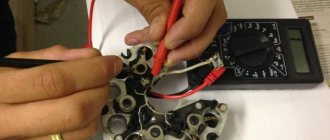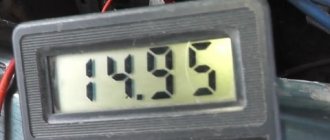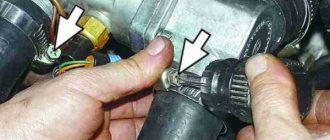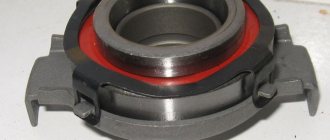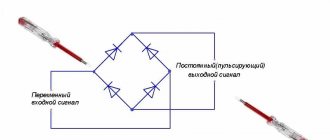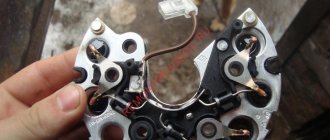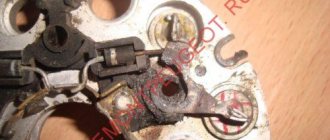Generator VAZ 2109
The main source of current in any car is a car generator. If the battery is not charged correctly, you need to know how the generator is tested in order to fix such a malfunction yourself. Most often, on a VAZ 2109, it is necessary to replace the diode bridge in the generator, but first you need to make sure of the existing problem. On a VAZ 2109, replacing the diode bridge of the generator can be done on your own.
Note! Before you begin repairing or replacing the diode bridge, it is imperative to evaluate the performance of the generator brushes, and also check the voltage regulator.
Examination
It happens that the generator begins to act up ahead of schedule and the battery does not charge properly. Actually, it serves to ensure the operation of the source of electricity to power all cars - the battery.
We advise you to rely not only on our instructions, but also on video lessons that will allow you to carry out repairs and replacements with your own hands, even without much experience.
Troubleshooting
The first step is to determine whether your generator is actually the source of the problem. To check, you need to carry out a series of sequential activities.
- Start the engine and let it warm up to operating temperature.
- Increase the crankshaft speed to approximately 3 thousand rpm.
- Turn on all the headlights, activate the high beams, start the heater, emergency lights, heated glass, and wiper blades. That is, all electricity consumers should be turned on as much as possible.
- Measure the voltage on the battery.
- If the device shows less than 13V, then a short circuit or break has most likely occurred in the generator windings.
- Another option is a breakdown of the voltage regulator, oxidation of the contacts of the excitation winding ring.
You can check for breaks and the condition of other elements of the generator only by dismantling it. But if you don’t have any experience in disassembling a generator, then you shouldn’t try to go there with your own hands. Replace the entire assembly or entrust the repair to professionals.
The most important thing is to understand that the generator, like all components of the car, must be monitored and serviced in a timely manner. Change brushes in a timely manner, do not allow large amounts of dust and dirt to get in, not to mention water. Ensure that the alternator V-belt is properly tensioned so that it is neither loose nor overtightened.
It is recommended to check the technical condition of the generator every 15,000 km. mileage Typically, with proper care of the generator, it can last up to 160,000 km. mileage and repairing the generator with your own hands is simply not necessary, you just replace it and that’s it.
Causes of diode breakdown
The diode bridge burns out due to overload due to excess current consumption. This happens due to the connection of consumers with a load exceeding the calculated value.
Examples of diode bridge output are:
· incorrect actions to “light” someone else’s car with the engine running in your own car;
· reversed polarity of the battery when lighting a cigarette;
· a short circuit between the plates of heat sinks connected to the “ground” and “plus” of the generator by random metal objects or conductive bridges made of dust and dirt can cause a fire along the generator-battery circuit. Therefore, the heat sink plates are partially insulated.
· connection of powerful acoustics with a soft buffer with a large load, increasing the rated current for which the generator is designed;
· short circuit in the banks of a faulty battery;
· microcracks appearing from temperature changes under the hood of the car, as a result of condensation or ordinary moisture entering the cracks from careless driving;
· sometimes diodes fail on their own.
Diagnostics
To check, the generator does not need to be removed. The test is carried out using a tester. You can use a cheap Chinese tester. The two probes of the measuring device need to be connected to the battery terminals and the voltage checked.
Analysis of voltage values makes it possible to judge the health of the generator set. What voltage the generator device produces can be found in the manual.
Unit location
Signs of device malfunction:
- The charging indicator light is constantly on or flashes when the engine is running;
- the battery either does not discharge completely or receives an increased charge;
- The headlights do not shine well enough when the engine is running, poor performance of other electricity consumers;
- the headlights are too bright, the electrolyte in the battery boils;
- heats up at high voltage;
- increased noise during engine operation from the generator side.
There may be problems in the brush assembly, which may be due to a malfunction of the brushes, their size, or problems with the three-level regulator. It is impossible to check the size and serviceability of the brushes without removing the generator. But you can change the brushes.
Signs of worn brushes:
- no battery charging;
- Voltage jumps when charging;
- The on-board voltage in the network is below normal.
If the brushes are less than 0.5 cm long, that is, they do not correspond to the required size, they need to be replaced. The condition of the brushes is checked to see how the brushes move in the grooves. After replacing the brushes, the generator restores its operation after a few minutes when the slip rings and brushes grind in.
Three-level voltage regulator
The three-level regulator should be checked along with the brush holders. If the regulator is working properly, the voltage should be 14.7 V. If the voltage is less than 13 V, the regulator must be replaced with a new one, since it maintains the required voltage for devices in the on-board network. If the regulator is faulty, the installation heats up. The procedure for replacing the three-level regulator is similar to replacing the brushes, since the devices are removed together.
Problems are possible not only with the cheeks, but also with the diode bridge.
Signs of a diode bridge malfunction:
- There is no charging at all;
- charging significantly exceeds the permissible values.
Repairing a diode bridge by replacing its spare parts is problematic. Therefore, the problem can be solved by replacing the diode bridge with a new one. When replacing the diode bridge, install the contact bolt, install the leads of the stator windings, and install the brush assembly. After installing the protective casing, the diode bridge is mounted, the power supply is connected and the drive belt is put on the pulley. After installing the belt on the pulley, check the tension of the drive belt.
Generator burnout or what is a diode bridge
When they talk about the generator burning out, they mean the diode bridge. It is a mandatory component of the generator.
Diagnosing a car with a burnt-out gene can be done easily. But repairs will require some effort and specific knowledge. It will be necessary to carefully study the design of the generator in order to be able to disassemble it, thereby getting to the diodes.
How to check the diode bridge? First of all, check the readings with the values on the dashboard. There is an icon that resembles a battery. After starting the engine, this icon should go out. Thus, the motorist is informed that the power supply to the main electrical components of the car has been switched from the battery to the generator.
But if the icon does not go out, then this is a cause for concern. The system gives a signal that a breakdown has occurred in the circuit. The reason still needs to be clarified more specifically, because this may also indicate a weak or damaged battery.
The main marks confirming damage to the diode bridge are the following:
- leakage current;
- fast and frequent battery discharge;
- small spark on spark plugs;
- reduction in cooling fan power;
- unstable operation of the air conditioner;
- interruptions in the functioning of the sound system;
- poor lighting of the optics while the engine is running.
Read also: How to connect a receiver for digital television
By looking at the headlights, many experienced motorists will immediately determine the faulty gene, without confusing it with battery problems. If the headlights shine dimly when the engine is off, the battery is to blame; if when the engine is running, it’s the generator.
If the diodes burn out, don't panic. It is better to find out the reason why this happens. Below we will describe instructions that imply autonomous diagnostics of DM.
The generator will need to be disassembled to gain access to the diode bridge.
- the current at the gene outputs is checked (it should not be lower than 13.5 V);
- At the same time, you need to check the instrument readings to see if the indicator continues to light after starting the internal combustion engine (provided that the gene is connected to the car);
- check the diode bridge with a voltmeter (if the meter needle moves into the red zone, the diodes are definitely faulty).
However, these signs, even if they are identified in their entirety, cannot yet prove 100% failure of the diode bridge, since similar symptoms indicate a breakdown of the chocolate bar (regulator).
Experts advise using the exclusion method in this case. That is, check the voltage regulator. If it is working properly, there is definitely a problem with the bridge.
The diode bridge is professionally tested with a multimeter. The device must be set to sound indication mode. If the multimeter does not have this ability, then you will have to measure in 1-kOhm mode.
It is noteworthy that individual measurements are carried out for diodes. In particular, the ends of the diodes should be touched with the probe of the measuring device several times, changing the terminals of the device each time. In one of the cases, the test should show BRS (infinity resistance), in the other - Ohm fluctuations in the range of 500-700.
A diode can be considered damaged if the readings are the same when measured in different directions.
Diodes are also checked using an indicator. This is done like this:
- gene protection is dismantled;
- The DM plate is connected to the negative terminal of the battery;
- The indicator is connected at one end to the positive terminal of the battery, and at the other end it is checked.
If, after touching the second end of the indicator to the diodes, the light bulb lights up, then the element is damaged.
How to check the health of the generator
Generator type 94.3701 alternating current, three-phase, with built-in rectifier unit and electronic voltage regulator, right rotation (drive side).
The generator connection diagram is shown in Figure 1.
The voltage to excite the generator when the ignition is turned on is supplied to terminal “D+” of the regulator (terminal “D” of the generator) through indicator lamp 4 located in the instrument cluster.
After starting the engine, the excitation winding is powered by three additional diodes installed on the generator rectifier block. The “W” output of the generator is not used on vehicles of the VAZ-2115 family.
The operation of the generator is controlled by a warning lamp in the instrument cluster.
When the ignition is turned on, the lamp should be on, and after starting the engine, it should go out if the generator is working.
A brightly burning lamp or glowing at full intensity indicates a malfunction.
The “minus” of the battery should always be connected to ground, and the “plus” should always be connected to the “B+” terminal of the generator.
Failure to turn the battery back on will immediately cause increased current through the generator valves and damage them.
It is not allowed to operate the generator with the battery disconnected. This will cause short-term overvoltages to occur at the “B+” terminal of the generator, which can damage the generator voltage regulator and electronic devices in the vehicle’s on-board network.
It is prohibited to check the functionality of the generator “for spark” even by briefly connecting the “B+” terminal of the generator to ground. In this case, significant current flows through the valves and they are damaged.
The generator can only be checked using an ammeter and voltmeter.
The generator valves are not allowed to be checked with a voltage of more than 12 V or with a megger, since it has a voltage too high for the valves, and they will be broken during testing (a short circuit will occur).
It is prohibited to check the vehicle's electrical wiring with a megger or a lamp powered by a voltage of more than 12 V. If such a check is necessary, you must first disconnect the wires from the generator.
The insulation resistance of the generator stator winding with increased voltage should be checked only on a stand and always with the terminals of the phase windings disconnected from the valves.
When electrically welding components and parts of the car body, you should disconnect the wires from all terminals of the generator and battery.
Modification of the VAZ 2110 generator (installation of a diode)
| The vehicle charging voltage level must comply with the requirements of the vehicle instructions and be within the range of 13.9-14.4 Volts, regardless of the operating mode of the engines and switched-on consumers. How to increase the voltage of a VAZ 2110 without much effort? One of the simple options was suggested by Illuzion. |
Modification of the VAZ generator from Illuzion
There are many consumers in the car: air conditioning, heated seats, etc., then with everything turned on, the voltage dropped to 11.2V. You can increase the voltage in a VAZ 2112 car by 10% if you install a diode in the VAZ generator. For example, a diode from another similar diode bridge or KD202V. After modifying the VAZ generator, the voltage rose to 12.2V.
Photo report on increasing voltage from the Gloom Garage website
It was decided to increase the voltage using a diode in circuit D, the voltage regulator. Any diode with a breakdown voltage of 20V and a current of at least 5A is suitable. The voltage drop is preferably no more than 0.6-0.7V. The 2D219B diode is excellent.
| Urev(V) | Ipr(A) | Upr(V) | Irev(mA) | Frame | |
| 2D219A | 15 | 10 | 0.6(10A) | 20 (15V) | KD-11 |
| 2D219B | 20 | 10 | 0.6(10A) | 20 (20V) | KD-11 |
| 2D219V | 15 | 10 | 0.45(10A) | 20 (15V) | KD-11 |
| 2D219G | 20 | 10 | 0.45(10A) | 20 (20V) | KD-11 |
You will need half a meter of wire 2*0.75mm. We solder the ends to the female and male terminals No. 4. We dress them in cambric, or better yet, heat shrink. On the other side, we solder the diode. A mother to the cathode, a folder to the anode. We isolate the diode itself, for example, put it in a can of photographic film. Remove the “-” terminal from the battery. We unscrew the “+” wires from the generator, disconnect the “D” wire to the tidy. Having gained full access to the back cover, remove it by prying 3 latches. Here in front of us is our voltage regulator. Having threaded the wires from the diode through the slots in the cover, we connect the “mother” to the LV, the “father” to the standard wire. Close the lid and screw all the wires into place. I left the wire short, so I had to attach it to the phase sensor harness. The result is presented in table form:
| Load | Voltage up to | Voltage after |
| without load | 14.2 | 14.45 |
| +dimensions | 13.8 | 14.45 |
| +PTF | 13.7 | 14.4 |
| +neighbor | 13.6 | 14.35 |
| +heater | 13.5 | 14.3 |
| +Fan | 13.4 | 14.2 |
| +far | 13.2 | 14.1 |
| + heating | 13.1 | 14.0 |
| +heater max | 12.9 | 13.95 |
The process of modifying the generator is also shown in the video: If you need to remove or disassemble the generator, you can use these instructions.
xn--2111-43da1a8c.xn--p1ai
Checking with an indicator screwdriver
This is the simplest test option, which will give a general idea of the state of the diode bridge and the entire circuit as a whole.
To operate, you only need an indicator, the entire procedure is performed under voltage, so extreme caution should be used:. Touch the tip of the screwdriver to each AC voltage terminal of the diode bridge in turn.
If the light does not light, this indicates a fault in the circuit up to the diode bridge - a broken winding, a broken charger, etc. If the light is on, then voltage is supplied to the bridge normally.
Touch the tip of the screwdriver to each AC voltage terminal of the diode bridge in turn. If the light does not light, this indicates a fault in the circuit up to the diode bridge - a broken winding, a broken charger, etc. If the light is on, then voltage is supplied to the bridge normally.
Rice. 2. Testing with an indicator screwdriver
- Also touch the positive terminal with a screwdriver - if the light comes on, then the diode bridge normally passes positive half-cycles, respectively, there is potential at this pin. If it does not light, there is damage to the diode bridge.
- Repeat the same procedure with the negative terminal. Be sure to divide the test into both terminals of the rectifier unit, since a fault may be present in any diode and in any branch.
As you can see, in this example an insulated blade screwdriver was used. This is due to the need to perform work under voltage, when you can cover different parts of the electrical installation with a metal part, which will entail extremely unpleasant consequences. A significant disadvantage of the method is its low information content and the limitation on the operating voltage - since the indicator is designed for a nominal value of 220 V, it cannot be used for low-voltage circuits.
Why is the battery not charging?
Before writing about the main reasons why the battery may not charge on VAZ 2109-2108 cars, I would like to warn all readers that the list I have given is not complete and is compiled only based on personal operating experience. So, during my short 10 years of driving experience, I had to operate a lot of cars and there were quite a lot of problems with charging the battery, and I will try to write about the main ones here.
It's no secret that the main device that is responsible for the normal operation of electrical appliances in a car is the generator. It is precisely because of the failure of some of its parts that charging may disappear completely or become weak. The main malfunctions of the generator, which entail a decrease in the charge current to the battery:
- Wear of generator brushes. This is a very common and most common reason. If they are worn down to the minimum permissible height, then the charge may disappear gradually, and then disappear altogether. To solve this problem, you just need to replace the brushes with new ones and that’s it.
- Failure of the diode bridge. The most reliable diode bridges are usually installed on VAZ 2109-2108 cars from the factory. And they are the ones who travel the most kilometers! This has already been tested not only by me, and any experienced auto electrician will confirm this. If one of the diodes or the entire rectifier unit burns out, then it also needs to be replaced. The procedure is not very fast and pleasant, but it will not cause much difficulty. Just below I’ll put a link to a page that describes the entire generator repair process.
- A more complex generator breakdown, such as a break in the rotor or stator winding. Of course, this is rare, but it still happens sometimes. The cost of these spare parts is quite low, so it is better to buy new ones and install the burned ones together than to buy a new generator.
- Poor charging may be due to slipping of the alternator belt. This becomes especially noticeable in damp or rainy weather, or when water gets on the belt. It begins to whistle, causing it to slip on the pulley, thereby preventing the generator from gaining sufficient speed to optimally charge the battery.
If you have problems with your car that are described above, then you can read all the maintenance procedures here: Repairing a generator on a VAZ 2109-2108 with your own hands. Everything is described there in quite detail and even for beginners the information will be very useful, and understanding it will not be difficult.
More details about replacement
Of course, this procedure can easily be performed by a technician at the nearest service station. However, many car enthusiasts prefer to repair or change parts on their car themselves. If you have knowledge and experience in this matter, then follow this algorithm:
- At the very beginning, you should turn off the power to the VAZ-2110.
- Next you need to disconnect the battery.
- Then pull out the pink wire that turns on the generator. To do this, unscrew the nut from the positive bolt.
- Then you need to loosen the upper and lower nuts and remove the tension bolt. After all this, you need to remove the belt.
- Next, the generator is turned 90 degrees, removing the lower mounting bolt.
- Then all connections need to be cleaned, including the rectifier housing.
- The upper part must be cleaned especially carefully.
- After this, the mechanism is replaced, and all connections are assembled in the reverse order.
- Finally, you need to check how the generator works.
When purchasing a new mechanism, you need to know that it must come with a warranty card. That is why you should buy only in specialized stores. If you find it difficult to replace the diode bridge yourself, then it is better to entrust this work to specialists from the technical service. They will easily perform the replacement, without removing the generator and with a guarantee.
Published 01/27/2021 Author: Iris-Auto
In the Electrical section
Removing the generator on the “eight”
To dismantle the unit for replacement or repair, you will need “17” keys and a mounting blade. Before starting work, be sure to generously treat all threaded connections to facilitate dismantling. The procedure looks like this:
- Disconnect the negative terminal from the battery.
- Unscrew the top nut securing the generator housing to the bracket.
- Unscrew the nut on the lower mounting bolt.
- Slide the generator housing towards the engine block and remove the belt.
- Unscrew the nut from the power contact and move the wires to the side.
- Remove the lower mounting bolt.
After all these manipulations, you can completely dismantle the unit. This can be done either from below, if protection is not installed on the car, or from above.
Checking for serviceability
Repair of the VAZ 2109 or VAZ 21099 generator is carried out in case of failures in the operation of the unit. There are several ways to determine generator malfunctions. The most optimal of these is diagnostics using a multimeter, but you will also need an assistant to carry it out. We will tell you further about how to check the generator on a VAZ 21099 or 2109 using a tester.
So, to determine generator faults with a multimeter, follow these steps:
- First of all, it is necessary to diagnose the VAZ voltage regulator. As practice shows, if the generator on a VAZ 2109 or VAZ 21099 does not work correctly, the problem may lie in the functionality of the three-level voltage regulator. This is especially facilitated by overvoltage in the electrical circuit. To check, you need to set the voltage measurement mode on the tester. So, start the engine and measure the voltage at the battery terminals or at the terminals of the generator unit itself. If everything is normal, then this parameter will fluctuate around 14-14.2 volts. Then press the gas and check the parameter again - it should increase, but no more than 0.5 volts. If the indicators on a VAZ 2109 carburetor or VAZ 21099 injector are different, this indicates that the element is not functioning correctly. Most likely, the VAZ 2109 voltage relay will have to be replaced.
- Next, the diode bridge of the generator is diagnosed. The bridge itself consists of six elements, three of which are considered positive and the remaining three are considered negative. Some diodes have mass at the anode, and the other part at the cathode. To check the diode bridge of the VAZ generator, the tester is switched to sound mode, that is, when the probe outputs are shorted, you can hear a characteristic sound. You are required to test each diode in different directions, and the sound should be heard in only one of them. If during testing the sound is heard in both directions, this indicates that the diode is broken. The best option would be to replace the diode bridge.
- Before disassembling the unit and repairing it, check the functionality of the stator; it is a steel cylinder, inside of which the winding of the mechanism is located. For diagnostics, you need to disconnect the stator leads from the diode bridge. First, inspect the element visually - there should be no signs of damage or burning. The multimeter is set to resistance measurement mode. First, measure the resistance parameter between the winding terminal and the housing (any terminal can be used). The obtained indicators should be high and tend to infinity. If the readings are 50 kOhm, this indicates the need to replace the generator.
- Using a multimeter, you can also check the performance of the rotor - it is a steel rod with a wound winding. At one end of the rod there are rings through which the brushes of the VAZ generator pass. You need to dismantle the rotor and visually inspect the condition of the generator winding and bearing. The integrity of the winding can be checked using a multimeter, after which the resistance parameter between the rings is measured. The results obtained should be no more than a few ohms. Replacing the VAZ 2109 generator brushes is required if they are worn out.
Node diagnostics with a tester
Modification of the VAZ 2110 generator (installation of a diode). When there is something to do
Installing additional equipment on a car requires increasing the on-board voltage, so modifying the VAZ 2110 generator (installing a diode) will be of interest to many. Modern domestic cars are increasingly equipped with additional equipment with each model. If the first VAZ models had generators providing a current of 40 amperes, today 80, 90, or even 100 amperes are becoming insufficient. Many owners independently install additional electricity consumers, such as car subwoofers, fog lights and the like. Modification of the VAZ 2110 generator (installation of a diode) will be a pressing issue for them, which is why the need to write such an article arose. Carrying out such a modification is not difficult and can be done by anyone who knows how to hold a soldering iron, knows how to use a multimeter and can distinguish a semiconductor diode from a capacitor or resistance. A few words about its design The generator set of this car is a fairly reliable device that can withstand vibration loads well and temperature changes in the engine compartment. She is also not afraid of moisture and dirt getting in while driving. Its performance must be stable at any engine speed. Requirements for the generator:
- The strength of the current generated by the device must be such as to prevent the battery from being discharged, but to be recharged to the required level regardless of the connected consumers;
- Regardless of the engine speed and fluctuations in current consumption, the stability of the on-board voltage must be ensured.
It is an electrical machine that converts rotational motion from the engine crankshaft into constant voltage to recharge the battery. Its body consists of two halves, front and back. The back cover is responsible for attaching a brush assembly with a relay-regulator, a diode bridge, and terminals for connecting consumers of the generated electric current. The main component of this device is the stator, which generates electrical voltage. It is installed between the body halves, front and rear. A rotor with an excitation winding rotates in a housing on bearings. Voltage is supplied to this winding through copper rings on the rotor shaft, and it is supplied to them through a brush assembly mounted on the back cover. About possible modifications. Today, lovers of additional consumers of electric current in a car have two ways to increase the battery charging voltage. Let's look at them. Refinement of the relay regulator For any modification of the generator set, you need to have at least a little knowledge in the field of electronics. To modify the “relay” for an increased battery charging voltage, you need to purchase the same relay from a foreign car with an output voltage of 14.5 volts, it is indicated on the top cover. The further order will be as follows:
- You need to disconnect the original “pill” from the domestic relay. You need to use a heated soldering iron and tweezers;
- The same procedure is carried out with imported “things”;
- After this, an imported relay must be installed on the domestic brush assembly. Here you will have to work hard, since the pins do not match and they need to be bent and soldered correctly;
- After this, it is securely fastened with screws to the body, having previously been treated with a special heat-shrink paste.
- That's it, you can install the relay regulator on the generator and test it in action, it should produce a voltage equal to 14.5 volts.
How to install an additional diode This is another way to modify the generator set in order to increase the battery charging voltage.
This method is somewhat more complicated, since it will require complete disassembly of the generator. The modification consists of changing the connection of terminal D of the relay-regulator. In the diagram, an additional diode that needs to be installed is indicated in red. The 2D219B device is well suited for such a semiconductor device, but you can choose a similar one with similar parameters. You need to find about half a meter more of a two-core wire, two terminals “male” and “female” number 4, as well as a heat-shrinkable casing. At one end of the wire, terminals are soldered and insulated with heat shrink. The free ends of the wire must be soldered to the diode, the “mother” is soldered to the cathode, and the “male” is intended for the anode. Now you need to connect the “mother” to the RN terminal, and the standard wire is connected to the “father”. At this point, the alteration is completed, all that remains is to assemble the device, install it on the car and carry out tests. As you can see, the alteration is not so difficult. Modification of the VAZ 2110 generator (installation of a diode) will allow fans of loud music and additional lighting effects not to think that the battery is not charging enough. AutoFlit.ru
No charging VAZ 2109
>When driving a car, you should always pay attention to whether the battery is charging. The VAZ 2109 battery is needed only to start the engine
While the engine is running, all electrical appliances of the VAZ 2109 operate from. Naturally, if the generator stops working, the battery doesn’t last long. How can you tell if the battery has stopped charging? There is a standard voltmeter on the instrument panel. According to its readings, it is very clear whether the generator is working or not. When the VAZ 2109 engine is running, the voltmeter should show a voltage of about 13.5 - 14 V. If you notice that the arrow is always tilted to the right, that is, the on-board voltage is less than 12V, then there is no charging from the generator. It is also very convenient to monitor the voltage of the on-board network of the VAZ 2109 using a digital tachometer. It measures the voltage from the generator with an accuracy of tenths of a volt.
Generator VAZ 2109
I recently had the following situation: I was driving and I saw that the voltage on the instrument panel voltmeter was about 11 Volts. Clearly, there's something wrong with the generator. Well, as usual, there is no time to repair it, it’s dark and cold outside, there is no garage. Well, as always, you need to drive a car every day, you can’t do without it. Therefore, at night every day I put the battery on charge, and in the morning I put the fully charged battery in the car and drove. If you drive only during daylight hours, that is, without headlights, then the battery may last for several days. If, as I did, you have to drive to work in the dark in the morning, then in the evening the battery will run out completely. Of course, it all depends on how often you turn off and start the engine. A lot of battery energy is wasted just for rotating the starter, you can also try to drive without it, then the battery is needed only for the operation of the ignition system and light signaling (stops, turns). Until recently, I believed that no matter how dead the battery was, the VAZ 2109 could always be started from the pushrod. It turned out that this was not true. There is a certain degree of discharge when the starter no longer has enough strength to turn the crankshaft, but it is enough. I pushed it, put it in gear, started up and everything was fine. However, if the battery is completely dead, it does not even have enough power to form a spark. , don’t push, the VAZ 2109 won’t start until you recharge the battery. But still, what to do if the VAZ 2109 battery has lost charging? Of course, not every one of us is an electrician and can check the generator with all its diodes, stabilizers and collectors. The very first thing to do if the VAZ 2109 generator stops working is to check the generator brushes. It’s easy to understand that the VAZ 2109’s brushes are faulty or worn out. Turn on the ignition and look at the instrument panel.
Checking the serviceability of the VAZ 2109 generator brushes
If the brushes are faulty, then the battery charging lamp will not light up when the engine is not running. Or it will glow very dimly. After you start the engine, the light will continue to glow dimly. The dim glow is visible only in the dark; it cannot be seen during daylight hours. If the brushes are in good working order, then when the engine is not running, the battery charging lamp lights up brightly; if it is started, it immediately goes out. It should be noted right away that the VAZ 2109 produced before 1993 has old-style brushes. On the new VAZ 2109, brushes of a new type are installed, immediately with a voltage stabilizer. However, there are both new and old samples of VAZ 2109 brushes on sale. The cost of VAZ 2109 generator brushes is about $3-5. Replacing the VAZ 2109 generator brushes is very simple, the sequence is as follows: 1. Remove the ground from the battery
Removing the mass of the VAZ 2109
2. Disconnect the chip from the generator brush housing and remove the wires from the central stud of the generator.
Disconnect the wires from the VAZ 2109 generator
Wires pulled back
3. Now unscrew the two bolts securing the brushes to the VAZ 2109 generator housing. And slowly remove the brushes from the generator housing.
We unscrew the bolts securing the generator brushes of the VAZ 2109
4. If you want the new brushes to last a long time, you need to clean the generator commutator. To do this, loosen the nut on the generator mounting bracket, loosen the belt and remove it. We take fine sandpaper, press it against the commutator, and we ourselves rotate the generator using the drive wheel. In this way, graphite deposits from previous brushes are removed from the commutator. And the wear of the new brushes will be long. 5. Now we insert new brushes into the housing of the VAZ 2109 generator and clamp them.
Generator brushes VAZ 2109
6. We put back all the chips and wires of the VAZ 2109 generator.
VAZ 2109 generator brushes replaced
We check the functionality of the generator as indicated above.
see also
- Replacing the clutch of a VAZ 2107
- How much brake fluid is needed to replace a VAZ 2109
- VAZ 2109 rear door lock replacement
- VAZ 2107 replacement of rear seat belts
- VAZ 2109 replacement of windshield wiper motor
Replacing the fuel sensor VAZ 2109- VAZ 2109 fuel level sensor replacement
- Replacing a brake disc on a VAZ 2107
- Replacing the timing belt on a VAZ 2107 carburetor
- Replacing the high panel on the Euro for a VAZ 2109
Replacing the injector with a carburetor VAZ 2107

